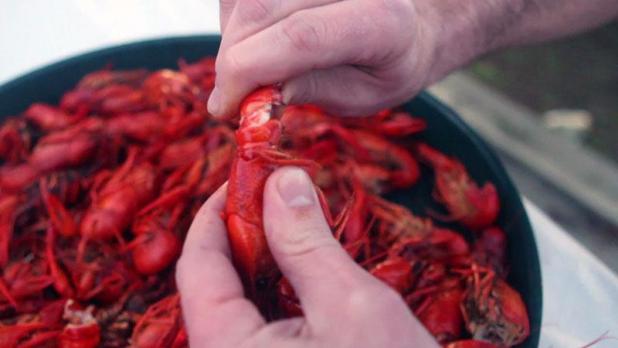
Crawfish season about to end due to loss of income
CROWLEY — Results from a survey of crawfish producers show that decreased demand for their product is resulting in lost income of about $500 an acre and a season that could end about 40 days sooner than usual in some cases.
“When you look at all those things, it’s a pretty impactful scenario for producers,” said LSU AgCenter economist Kurt Guidry, who compiled the survey results.
A total of 67 producers responded to the survey, representing more than 10% of the total estimated crawfish acres in the state, Guidry said.
The survey was conducted at the request of the Louisiana Farm Bureau and crawfish producers to make the U.S. Department of Agriculture and the Louisiana congressional delegation aware of the problems facing the industry.
Demand for crawfish has decreased as restaurants face restrictions imposed during the coronavirus pandemic. The shutdown hit when crawfish season was in full swing — and when producers make most of their income.
“It happened at the absolute worst possible time,” Guidry said.
The survey results could result in government assistance.
“It’s in the hands of the policymakers,” he said. “This is the first step to make sure policymakers are aware of the issues.”
The survey only addresses farm-raised crawfish and not the wild crawfish caught in the Atchafalaya Basin. Other faculty in the AgCenter and Louisiana Sea Grant are currently examining the economic impact to wild-caught crawfish fishermen.
Based on survey results, the average projected decline in wholesale prices for the entire production season is about 55 cents below the previous three-year average. For some producers, the drop in price has resulted in prices falling below their breakeven point.
Harvesting has been curtailed, and buyers are limiting how much they will buy from producers.
“On average, producers are harvesting more than two days fewer per week,” Guidry said.
In addition to the decreased harvest and lower prices, producers who hired foreign labor to bring in the catch are contractually obligated to pay those workers for a guaranteed amount for a full season’s work.
“It’s basically an expense some are having to pay without having a way to generate any income,” Guidry said.
The average starting date of the season for producers surveyed was in late December as usual. Producers indicated their season would usually end by mid-June, but the survey showed that, on average, producers felt their season could end by the first week of May this year because of either below-breakeven prices or a lack of available market outlets.
For many rice farmers, crawfish has been a way to fill the economic gap created by low rice prices.
“For a lot of producers, they rely heavily on crawfish,” Guidry said.
Some individuals who responded to the survey reported that this was their first year to harvest crawfish, and they had invested substantially to buy harvesting equipment.
Some crawfish producers have drained their fields because they were unable to sell their harvest at a profit, Guidry said.
Mark Shirley, AgCenter and Louisiana Sea Grant crawfish specialist, said draining a pond that is overpopulated could be done quickly to reduce the population. A field that is not overpopulated should be drained slowly over two to three weeks to allow the crawfish to burrow so they can reproduce for the next season.
Restocking crawfish in early planted rice fields can be done in May.
Shirley said he has found a few fields with the white spot virus.
“I don’t know if it’s 10%, 20% or just 5%, but it’s out there in a lot of the ponds,” he said.
There is no cure for the disease, and it returns the following year in some fields, but not all.
AgCenter scientists are currently sampling ponds to determine how widespread the white spot virus is and what conditions trigger some of the crawfish to die in the pond.
“Fortunately, the white spot virus only affects crustaceans and not humans or other animals,” Shirley said.
Jeff Durand, who farms with his brothers in St. Martin Parish, said they have drained some fields because of the limited market.
“We would have gone another month or two in those fields,” he said.
Durand said they are only harvesting three days a week.
The Durands lost several big orders, and the restaurant business has decreased considerably. The peeler market also is down. But the drive-thru boiling businesses are buying.
“We’re lucky to be moving some crawfish,” Durand said.
Paul Zaunbrecher, who farms with his brothers in Acadia Parish, said their business is surviving because they have a large grader that allows them to cull large crawfish.
“We’re not suffering as bad as most people. We’ve got some good buyers,” he said.
Zaunbrecher said the market has increased significantly with more acreage and more people in the crawfish business.
“A lot of our markets just dried up,” said Alan Lawson, who farms with his father in Acadia Parish.
He harvests crawfish from their rice ponds, and he buys crawfish to be peeled.
Lawson said he’s had no choice but to peel a large amount of big crawfish.
“We’ve had some pretty good sales with the tail meat,” he said.
Lawson said he has had to reduce the amount he buys from other farmers because markets have disappeared or declined, and he suspects many farmers stopped harvesting crawfish.
He also has a whole-boiled operation to freeze boiled crawfish.
“The whole-cooked market just went away. We had hundreds of thousands of pounds that would have been sold,” Lawson said.
He said crawfish businesses like his won’t be able to take advantage of the federal payroll protection program because the workers are foreign.
When the economy emerges from hibernation, the crawfish industry won’t make a quick recovery because it is a seasonal business that peaked when the coronavirus shutdown occurred.
Lawson is trying to stay positive.
“We’re all just going to make the best of it like we always do,” he said.
